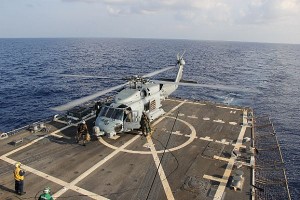 As ubiquitous as maritime helicopters are, America often forgets that the sustained operation of rotary-wing craft off smaller surface combatants only really started in the sixties.
As ubiquitous as maritime helicopters are, America often forgets that the sustained operation of rotary-wing craft off smaller surface combatants only really started in the sixties.
Today, it’s easy to scoff that helicopters got their start aboard combatants decades ago, but…for the U.S. Navy, the regular use of helicopters aboard smaller combatants spans only a few generations of hullform–in an evolutionary sense, this means America is still learning what works. Given the chronic (and sometimes catastrophic) problems of integrating helicopters to the low-freeboard DDG-51 flight deck, the U.S. Navy may not have the right answer yet.
It’s high time for some serious thinking. The U.S. Navy hasn’t been helped by the fact that ongoing struggles with the mundane issue of landing and keeping helicopters aboard small combatants has fallen through the cracks for decades.
Take this story on a 2013 mishap aboard the USS William P. Lawrence:
In the decades before the Lawrence tragedy, helicopter pilots and ship crews repeatedly warned about the hazards on low-freeboard flight decks, messages that were either missed or ignored in a breakdown of the Navy systems used to identify and mitigate hazards. They called for changes that, if instituted, might have prevented the deaths, recommendations adopted only after it was too late.
The dangers of wave impacts on frigates and destroyers were reported in 13 hazard reports filed between 1983 and 2013, HAZREPS obtained by Navy Times in a 2-month-long investigation and presented publicly for the first time. These messages are chock full of warnings from aviators that presage the tragedy of Sept. 22, 2013.
In contested seas, failure to facilitate safe launch-and-recovery of rotary-wing craft across the entire span of a surface combatant’s operational profile is going to be a real problem. The challenge isn’t going away–in a few years, unmanned rotary-wing platforms will be an absolute requirement for survival in a contested environment, and engaged surface ships won’t be able essentially stop maneuvering to launch and safely recover stuff.
Fighting surface combatants will need to launch and recover at speed while maintaining full maneuverability–something that might be impossible given the Navy’s huge inventory of low-freeboard flight-decks.
So let’s not take our eyes off the underlying systems engineering challenge. It will be all too easy for aeronautical engineers, in all the excitement of fitting fancy sensors, comms gadgets and weapons to all the neat and new unmanned airframes out there, to overlook the critical-yet-mundane job of ensuring operational integration to the ship.
All Navy stakeholders–SWOs and Flight Crew alike– would be smart to take a moment and remember that helicopters are still kinda new additions to the surface combatant arsenal. There is still a lot to learn. The Kamen LAMPS Mk1 Seasprite, for example, began operating off Garcia Class Frigates, and helicopters only had a chance to integrate onto three subsequent Frigate-sized hulls (the Brooke, Knox and Perry Classes). For Destroyers, the Coontz Class had a platform, but that was pretty much it until the Spruance, Kidd and DDG-51 Classes. With only two or three hull-form “generations” available to obtain operational experience, there’s just not been a hell of a lot of room to experiment.
As far as the future goes, the U.S. Navy seems likely to maintain the low-freeboard DDG-51 even though the DDG-51 flight deck is too low to reliably use without forcing the ship into a constrained operational envelope.
There aren’t any alternatives; the only real “high-freeboard” platforms remaining in the surface combatant fleet are on CGs, the LCS-2s, the DDG-1000s and maybe, in a pinch, the NSC Cutter and EPF. But CG’s are leaving, the LCS-2s are at risk of getting cancelled, the DDG-1000s are too few in number and the NSC Cutter and EPF aren’t combatants. It’s low-freeboard or pretty much nuthin’.
So that begs the question: How are next-generation rotary-wing UAVs going to integrate with the low-freeboard DDG-51s? Can they be engineered to operate on–and survive–wet decks and wave strikes?
I don’t know.
So, as America starts really leveraging the potential of rotary-wing UAVs aboard small combatants, the UAV engineers need to revisit a basic operational premise–and ensure that their new “do anything” rotary-wing craft can actually land aboard a low-freeboard flight deck without interfering in the ship’s ability to, well, uh, fight.
Put another way, if Navy can’t figure it out, then the Navy will need to think about a new ship, operational concept, or….you get the idea.
Navy ain’t easy sometimes.

{ 1 comment… read it below or add one }
click through for comments